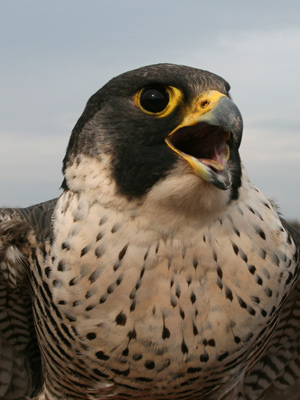Peregrine Falcon

The peregrine is seen as the aerial predator par excellence, taking most of its prey on the wing although sometimes on the ground. This species has received much monitoring and survey attention from members of the Scottish Raptor Study Group, with the great majority of peregrine breeding territories (at least in the more accessible parts of Scotland) being checked annually.
The peregrine is a species that has had mixed fortunes, at times benefiting and at times suffering from the hand of man. With the removal of most of Scotland’s original native forest cover (and consequent increase of open country prey species) there was probably great scope for population expansion of peregrines. The bird was highly prized for falconry purposes and its nest sites (or at least some of them) seemingly carefully protected for this purpose. Then with the game management era came sustained persecution of the peregrine, especially at its breeding sites. Protective legislation ensued, there was some population recovery but this was followed by the era of organochlorine pesticide contamination which led to a sudden and unprecedented peregrine decline in most parts of Scotland. With the gradual phasing out of the more damaging chemicals there came a welcome recovery in the peregrine population coupled with range extension.
There are however continuing problems. The criminal persecution of peregrines persists on some grouse moor estates, there is much criticism from pigeon fancying interests (not a new phenomenon), and annual national surveys repeated at ten year intervals have revealed continuing declines in the prey poor northern and western Highlands. The last such national survey (in 2002) recorded 544 peregrine pairs in Scotland.

The peregrine’s breeding habitat has been seen traditionally as craggy hill country and sea cliffs but there is a trend towards more breeding in lowland areas (especially in quarry sites) which to some extent at least has matched the possibly prey-related decline in the more remote uplands. Peregrine eggs are laid mainly in early to mid April and usually on a cliff ledge, an incubation period of some thirty days ensues and the young leave the eyrie at about six weeks of age, generally in the second half of June. They remain dependent on their parents for food for some two months but disperse thereafter.
The peregrine’s relations with other species are interesting and may merit further study. The golden eagle is apparently dominant in choice of nest site (as well as being a possible competitor for food) although peregrines will on occasion use deserted nests of golden eagles. They will also nest in disused buzzard and especially raven nests. The peregrine is often most obvious, both visually and audibly, in its interactions with these other species.
Patrick Stirling-Aird
References:
Amar, A. Court, I.R., Davison, M., Downing, S., Grimshaw, T., Pickford, T. and Raw, D. (2012). Linking nest histories, remotely sensed land use data and wildlife crime records to explore the impact of grouse moor management on peregrine falcon populations. Biological Conservation 145: 86-94.
Banks, A., Crick, H., Coombes, R., Benn, S., Ratcliffe, D. and Humphreys, E. (2010). The breeding status of Peregrine falcons in the UK and Isle of Man in 2002. Bird Study 57: 421-436.
Crick, H.Q.P.and Ratcliffe, D.A. (1995). The peregrine Falco peregrinus breeding population of the United Kingdom in 1991. Bird Study 42: 1-19.
Hardey, J., Rollie, C.J. and Stirling-Aird, P.K. (2003). Variation in breeding success of inland peregrine falcon (Falco peregrinus) in three regions of Scotland, 1991-2000. In Thompson, D.B.A., Redpath, S.M., Fielding, A.H., Marquiss, M. and Galbraith, C.A. (Eds.). Birds of Prey in a Changing Environment. The Stationery Office, Edinburgh. Pp. 99-109.
Ratcliffe, D.A. (1993). The Peregrine Falcon (second edition). Poyser, London.
Ratcliffe, D.A. (2003). The peregrine saga. In Thompson, D.B.A., Redpath, S.M., Fielding, A.H., Marquiss, M. and Galbraith, C.A. (Eds.). Birds of Prey in a Changing Environment. The Stationary Office, Edinburgh. Pp. 91-98.
Stirling-Aird, P.K. (2012). Peregrine Falcon. New Holland Publishers, London.
Scottish Raptors• Honey-Buzzard• Red Kite• White-Tailed Eagle• Marsh Harrier
Hen Harrier• Goshawk• Sparrowhawk• Common Buzzard• Golden Eagle
Osprey• Kestrel• Merlin• Hobby• Peregrine Falcon• Barn Owl
Tawny Owl• Long-eared Owl• Short-eared Owl• Raven
